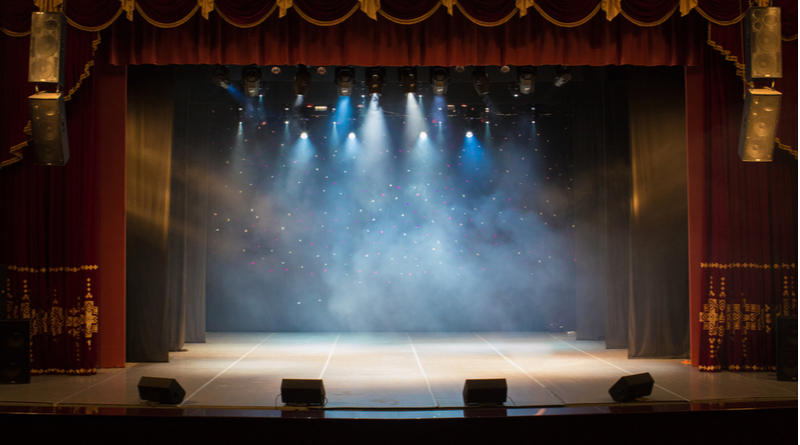What is Stage Design?
Stage design goes by many names in the theatre community, including stage design, production design, scenic design, and scenography. While these names hint at a diverse number of tasks and responsibilities, stage design is essentially the profession and process of planning and creating the scenery for each location in a performance’s action.
Stage Designers work with the director and other designers to establish an overall visual concept for the production and design the stage environment.
What 3rd level courses are available?
Universities and colleges in Ireland are offering courses in Stage Design in the following subject areas:
- Introduction to Set Design – An introduction to the basic stages of set design, from reading the script and creating a concept, to understanding what is required to design a set and create a model box.
- Introduction to Stage Management and Technical Theatre – A course for anyone who is considering training in stage management or any of the disciplines associated with technical theatre.
- Creative Drama and Theatre Arts – The Theatre Performance course provides training in core performance skills.
- BA In Theatre and Film Practice – Gain a solid grounding in the practical application of both theatre and film production skills.
- Musical Theatre – This intensive immersion in musical theatre will help build confidence, develop new skills and develop existing skills in a collaborative environment.
- The Greek Theatre – Study all aspects of Athenian drama in the fifth and fourth centuries BCE, from tragedy to comedy, including staging, contemporary audience, and later critical debates.
Studying Stage Design
Many courses in Stage Design may take place over a few days, weeks, or even 1 year to 4 years depending on the course and modules selected. There are also part-time courses and night courses available so you can be sure to fit in your studies no matter what your schedule is like.
Courses will cover theory work through lectures, assignments, tutorials, and taught modules. Assessments will take place continuously with written examinations and practical assignments combined to achieve a qualification.
You could also consider work experience or a work shadow in the industry. As with most jobs in the creative industries, competition is fierce. Getting involved with student theatre, film, or music societies will enable you to make contacts, gain experience of working on a production and build up your portfolio with examples of spatial design. Relevant work experience is a good way of demonstrating a genuine interest in the field and is regarded favourably by employers.
Career options
After completing a Stage Design course you will be able to get started in a career that uses specific knowledge of production, design, and the visual arts.
Stage designers are responsible for the visual concept of a stage production. They identify a design style for sets, graphics, props, lighting, camera angles, and costumes while working closely with the director and producer.
Once the concept is decided, designers usually appoint and manage an art department, which includes a design and construction team. They often form a strong partnership with a particular director, with who they’ll then work on many productions.
Designers tend to specialize in film, television, or theatre, although there is some overlap in the industry.
Working hours will depend on whether you are self-employed, employed by a company with set business hours, or if you are contracted to various businesses or companies. Working hours can be long and typically include regular unsocial hours and weekends. The nature of contract work often results in intensely busy periods interspersed with inactivity if no work comes in.
Part-time work is unlikely, although freelancers can control their workload by deciding which contracts to accept. The length of contracts varies according to the nature of the production and its budget.
Related jobs include:
- Stage Designer
- Set Designer
- Scenic Designer
- Theatre stage manager
- Theatre director
- Theatre director
- Film director
- Choreographer
- Actor
- Dancer
- Community arts worker
- Drama therapist
- Arts administrator
- Further education teacher
- Media researcher
- Music producer
- Secondary school teacher
- Special effects technician
- Talent agent
- Television floor manager
- Theatre manager
Further study
After completing a course in Stage Design you may choose to pursue further study in a specialist field to increase your knowledge base and skill set. Postgraduate study can also be used as a means to change career focus or to gain professional qualifications required to practice in certain career areas such as Architecture. Creative, performing or technical arts, Drama or theatre studies, Fine art or visual art, Graphic design or illustration, Interior design, Landscape architecture, and design, Theatre or performance design, and 3D design.
FAQ
What is the importance of Stage Design?
Stage Design has a huge impact on an audience’s experience of a play as it is the first thing they see when the stage is revealed to them. The design provides essential information such as setting, period, and the type of production you’re seeing.
Stage designers usually take responsibility for props too. Their role involves making decisions about everything in and around the acting space, such as furniture, raised platforms or playing areas, entrances and exits, and the shape of the space itself. If the production has painted scenery the stage designer may work with a scenic designer, who designs and paints scenery for the back or sides of the stage. Sometimes the two roles are combined.
What skills could be helpful for a career in Stage Design?
If you are considering a career in Stage Design, some skills may be helpful to have or start getting experience in, such as:
· A flair for generating original creative ideas
· The ability to communicate ideas through technical drawing and model making
· A good working knowledge of the visual arts and production processes
· A critical view of film, television, or theatre, and familiarity with the work of specific designers
· Persistence to follow up leads and gain work
· The ability to work with others, at all levels, as part of a team
· The capacity to manage a design project from start to finish, to tight deadlines
· The ability to be resourceful and adaptable and be able to solve practical and conceptual problems
· The capability to work independently
· The confidence and ability to appoint and supervise a design team or art department.
Where can I study Stage Design?
Explore your options here
Did You Know?
· Shakespeare’s Globe is the only building in London allowed to have a thatched roof since the Great Fire in 1666.
· One of the most unusual theatres in the world is The Seebühne (floating stage) in Austria. Featured in a few scenes in 2008’s Quantum of Solace, the theatre is the location for musical and opera performances on the shores of Lake Constance.
· Two seats are permanently bolted open at the Palace Theatre for the theatre ghosts to sit in.
· The Ghost Light – A light, often a bare bulb, is still left on the stage of many theatres so it is never completely dark.
· The first major use of revolving stages began in Japan in the 1750s and is currently most notably used in Les Misérables, with 63 rotations per performance.












Comments